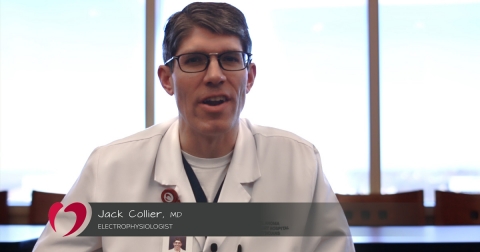Catheter Ablation: A Life-Changing Procedure for Many

At Oklahoma Heart Hospital, electrophysiologists are changing lives when they perform catheter ablations, a procedure used to treat a variety of heart arrhythmias. Ablation is effective at treating the vast majority of arrhythmias, ranging from atrial flutter and atrial fibrillation to premature ventricular contractions and ventricular tachycardia.
Following a successful ablation procedure, patients who previously could not exercise due to a heart arrhythmia are able to exercise to any level, including running a marathon. Patients who have dealt with a heart arrhythmia for decades have the procedure and then wonder, “Why didn’t I do this 20 years ago?” Some older patients may develop an arrhythmia but dismiss their symptoms as simply signs of getting older – greater fatigue, shortness of breath, or a fluttering feeling in their chest. Once treated, these patients are back to their normal active selves quickly. Some patients with heart arrhythmias have been told the heart-pounding feeling is anxiety or is “just in their head.” For patients who have never been diagnosed or have been misdiagnosed, just knowing there’s a medical reason for how they feel can be comforting on its own. Finding out there is a potential cure for that heart condition is even better news.
The first step in a patient’s ablation journey is the diagnosis of a heart arrhythmia. A family practice physician, internal medicine specialist, or a cardiologist will make an initial diagnosis of heart arrhythmia based on an in-office EKG or use of an at-home wearable heart monitor. Typical symptoms of heart arrhythmias include a racing heartbeat or feeling like your heart is pounding in your chest, beating too fast or too slow, or skipping a beat.
Once diagnosed with a specific heart arrhythmia, your physician will recommend a treatment plan. Some arrhythmias are life-threatening and require immediate ablation. For other less severe arrhythmias, patients may be prescribed medication to treat the arrhythmia first. If the medication is not successful in treating the arrhythmia or if a patient experiences side effects from the medication, a catheter ablation may be the next step.
During the procedure, your doctor will place catheters in the groin and use x-ray to guide them through the blood vessels to the heart. Once in the heart, the catheters can detect the electrical signals directly from the heart muscle to identify the abnormal tissue causing the heart arrhythmia. The abnormal tissue is then destroyed using either heat or freezing techniques. Patients may go home the same day or may be kept for observation overnight. Patients can return to normal activity levels — and much-improved activity levels for many patients — about a week after the procedure.
Whether you have a newly diagnosed arrhythmia or were diagnosed decades ago, contact the Heart Rhythm Institute at Oklahoma Heart Hospital to discuss whether ablation can help.




